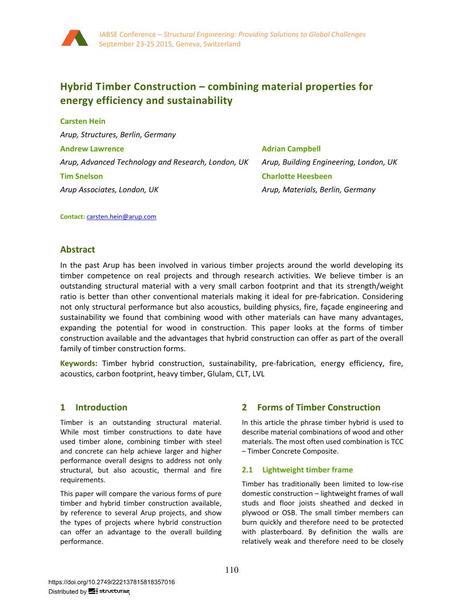Hybrid Timber Construction – combining material properties for energy efficiency and sustainability

|
|
|||||||||||
Bibliografische Angaben
| Autor(en): |
Carsten Hein
(Arup, Structures, Berlin, Germany)
Andrew Lawrence (Arup, Advanced Technology and Research, London, UK) Adrian Campbell (Arup, Building Engineering, London, UK) Timothy Snelson (Arup Associates, London, UK) Charlotte Heesbeen (Arup, Materials, Berlin, Germany) |
||||
|---|---|---|---|---|---|
| Medium: | Tagungsbeitrag | ||||
| Sprache(n): | Englisch | ||||
| Tagung: | IABSE Conference: Structural Engineering: Providing Solutions to Global Challenges, Geneva, Switzerland, September 2015 | ||||
| Veröffentlicht in: | IABSE Conference Geneva 2015 | ||||
|
|||||
| Seite(n): | 110-119 | ||||
| Anzahl der Seiten (im PDF): | 10 | ||||
| Jahr: | 2015 | ||||
| DOI: | 10.2749/222137815818357016 | ||||
| Abstrakt: |
In the past Arup has been involved in various timber projects around the world developing its timber competence on real projects and through research activities. We believe timber is an outstanding structural material with a very small carbon footprint and that its strength/weight ratio is better than other conventional materials making it ideal for pre-fabrication. Considering not only structural performance but also acoustics, building physics, fire, façade engineering and sustainability we found that combining wood with other materials can have many advantages, expanding the potential for wood in construction. This paper looks at the forms of timber construction available and the advantages that hybrid construction can offer as part of the overall family of timber construction forms. |
||||
| Stichwörter: |
Nachhaltigkeit Akustik Energie-Effizienz Vorfertigung Brand Carbon Footprint
|
||||

